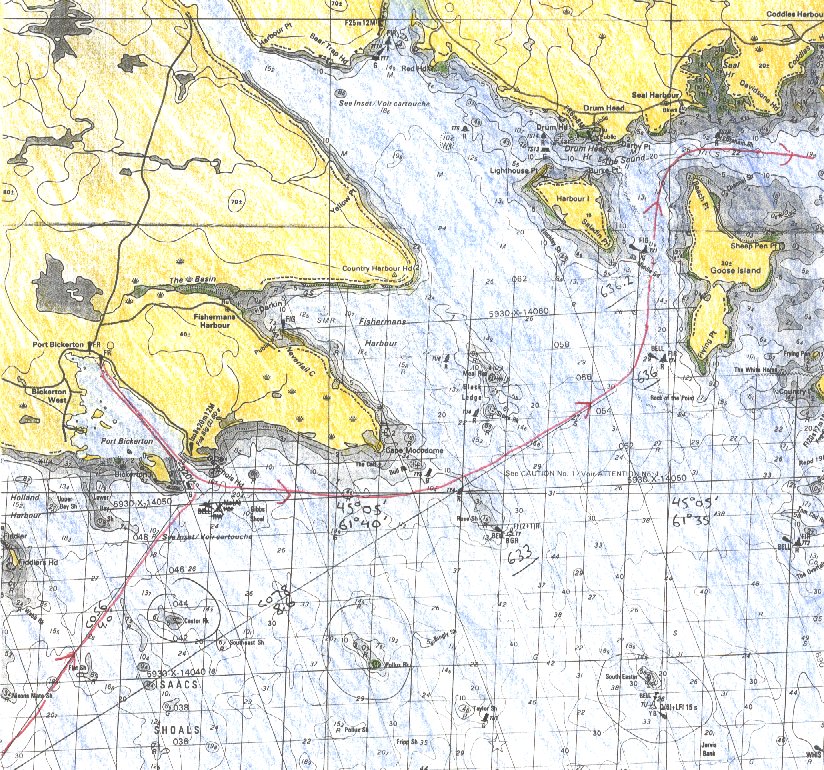 |
|
PORT DUFFERIN TO ST. PETERS NOVA SCOTIA CRUISE - 3 Jim Fraser's Ted Davis Trophy winning log. |
 |
| Monday, June 12
After washing up at the coast guard station, I chatted with the crew of the inflatable boat from yesterday. They apologized for the exhaust-gas attack and we talked about small boat cruising. Finally the sky was clear, but the forecast called for light winds. What does that mean? I had visions of sitting in the doldrums, with the sails slatting, Naomi rolling on her beams, and still being able to read the rust-streaked numbers and letters on the buoy I tried to sail past ages ago. My pessimistic attitude was wasted though. It became one of those ideal sailing days I see portrayed in yacht magazine ads but have rarely experienced. |
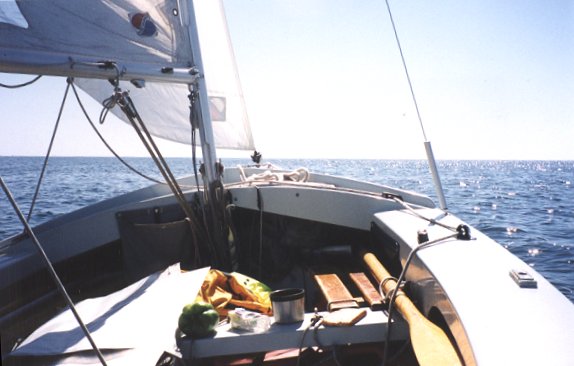 |
|
... |
| Naomi tacked slowly out of Port Bickerton on a zephyr
from the
southeast. To lengthen favourable tacks, I’d sail through the pot
floats,
pick an open spot, tack around the floats and lines and back into the
channel.
Slowly but steadily we worked out of the harbour mouth and past the
lighthouses.
The older lighthouse has been converted into a museum. There is an
excellent
view from the lighthouse as well as pleasant hiking trails along the
coast.
Beyond the granite point of Barachois Head, the sea sparkled with an
awakening
breeze. A steady force 3 wind rose. It remained unchanging in strength
till evening but gradually shifted from southeast to south to southwest
as the day passed.
Under the main and working jib, Naomi beat towards two spar buoys marking the passage between Bull Rock and Rose Shoal. Other than a half-dozen inshore boats hauling pots, I had the sea to myself. In no time I rearranged the cockpit floor so I was lounging on a foam sleeping pad with my back propped comfortably against the lazarette bulkhead and my legs stretched out beneath the thwart. Both the main and jib were cleated but the sheets near at hand. The tiller was bungyed to reduce response - only a light grasp with a hand or a push with a shoulder was required to steer during the 24-rnile passage on a starboard tack, from Port Bickerton to Tor Bay. Soon Naomi became my nautical picnic table. Cluttering the cockpit were juice boxes, cracker packets and half eaten vegetables. Cheese, peanut, and raisin containers sat open around me. Cookie crumbs, bread crusts, and candy papers lay where they dropped. While sprawled on the floor, I admired the scenery or closed my eyes and listened to the wind in the rigging and the gurgling wake astern. Sometimes, I craned my neck and daydreamed while gazing up to the taut white mainsail with the busy red burgee snapping over its peak. Beyond Cape Mocodome the coast receded deeply into Country Harbour, a 13-mile-long deep water estuary -- one of the best natural harbours in Nova Scotia. Bad weather bolt holes in Fishermans Harbour and Isaacs Harbour were passed heedlessly. The hillside near Isaacs Harbour is scarred with the towers and buildings of the Sable Island offshore gas project terminus. |
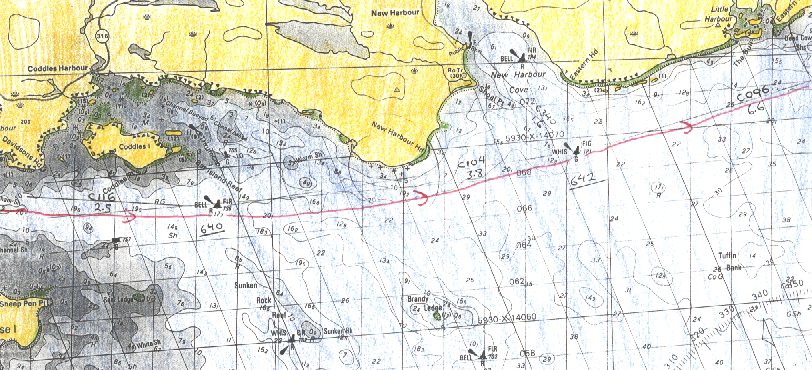 |
| To avoid the shoals off Country Island, I headed toward the
coast between
Harbour Island and Goose Island. The south point of Harbour Island is
named
Saladin Point after a ship by that name which ran aground and broke up
here in 1844. The six remaining crew members had killed the captain and
their crew mates during a passage from Valparaiso in Chile. They hoped
to scuttle the vessel and escape with silver and money which the ship
carried
but abandon the main cargo of guano. The mutineers were
transported
to Halifax and tried at court. Four of the men were hung on the South
Commons.
In 1988, a tall ship - the Merkur - ran aground on Goose Island
across from Saladin Point. The crew were saved but the irreplaceable
vessel
was smashed to pieces on the shore of Flying Point.
The long spit in the north shore of Harbour Island as well as Drum Head, were additional shelters I ignored in these stable weather conditions. Coddles Harbour in particular, looks like the rock and islet congested coves which Wayfarer sailors sniff out. Now the only shelter along the coast before Tor Bay was New Harbour which is a tiny notch protected by an artificial breakwater. Naomi cantered along, her stem raising and lowering rhythmically, changing my view from shiny gray foredeck and sky to the unbroken line of sky and water on the horizon. Other than an occasional scan for shipping and standing clear of Shag Rock and Dead Cow Shoals, I just glanced at the compass from time to time. Soon Whitehead Island appeared in the distance directly over the bow and this became my mark to aim for without even glancing to the compass. |
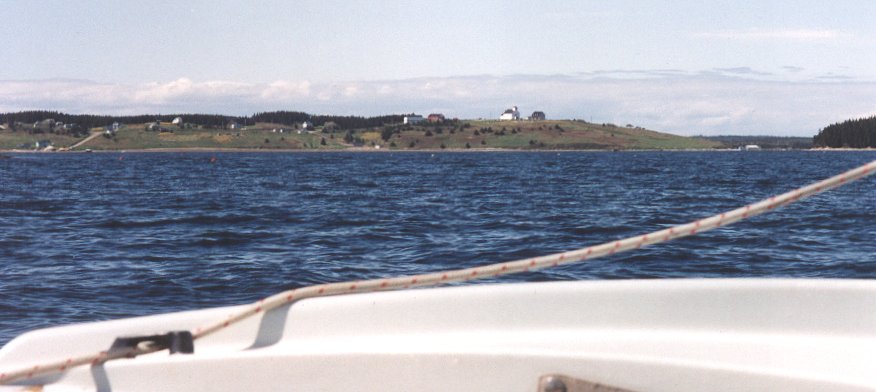 |
|
|
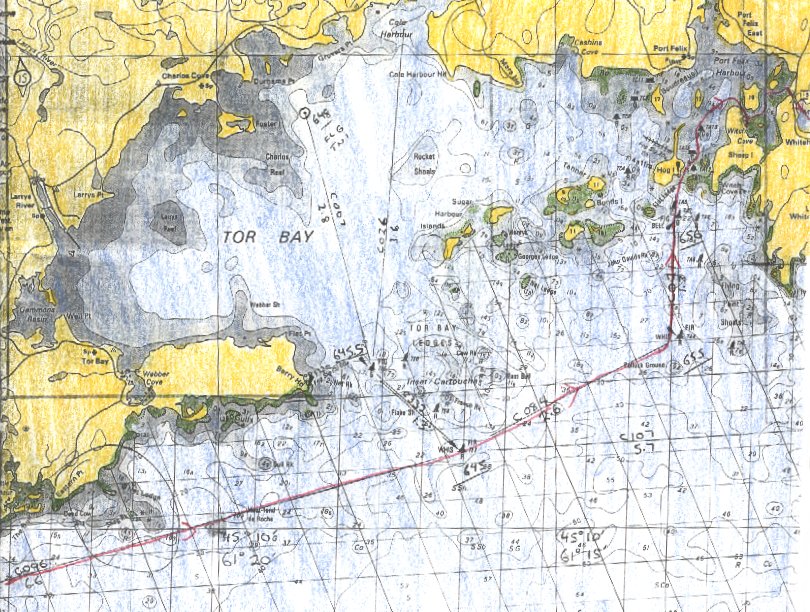 |
| Tor Bay opened to port. Because the hills backing Tar Bay are
largely
grassland, the white churches and homes of Charlos Cove, Cole Harbour,
and Port Felix stood out distinctly against the green backdrop. Passing
the main entrance to Tor Bay, I sailed outside Tor Bay Ledges and
Harbour
Islands. Arriving at the red whistle buoy TA4, I finally had to crawl
from
my lounging position on the floor and gybe Naomi onto a port
tack.
We followed a passage between Hog Island and Sheep Island before gybing
again and drifting into the shelter of Witch Cove. Here I nosed Naomi
ashore and took a long stroll along the sand beach before retiring to
the
shade of a dense spruce forest. Later I anchored Naomi in
deeper
water in Witch Cove and stood leaning on the boom watching a beautiful
sunset. In the future, I hope to recall this day’s sail as a balance to
occasions when a cruise goes wrong.
Late in the evening I clamber aboard Naomi from a rough gray-painted motorboat. For several hours I have been the guest of three lobster fishermen from Little Dover. We have been chatting away the evening in their small but cozy fish hut in Louse Harbour. I had barrelled into Louse Harbour during the afternoon in a force 4, gusting 5 southerly wind - favouring the obvious hazard of Louse Head’s solid granite buttress to the less obvious but just as dangerous rocks waiting awash or near the surface to port. In my mind were nagging doubts whether I might have made an error in navigation and I may be entering the harbour amongst the drying channel on the west of Louse Island. Navigating close-in by chart while boat handling alone in blustery weather makes dinghy cruising exciting. With the wind gusting down the harbour, I bore off for the lee of the shoreline behind Haynes Island. Rounding a huge stack of lobster pots on a wooden stage, I entered a small bight and lowered the main in preparation for anchoring. Unfortunately, the bottom, while deep, contained many huge boulders which would cause problems as the tide ebbed and Naomi swung at anchor. I rowed across to Haynes Island, anchoring in a more exposed location behind a low, natural rock breakwater. As soon as the anchor set, I erected the boom tent as a windbreak and lay back resting. A short time later, a young man motored around the point in a small boat. He came alongside and we talked at length. During lobster season, Terry stayed here at his fish hut except Thursdays when he returned to Little Dover with his catch. He had bought his father’s trap skiff, hut, license and 250 pots. Later in the afternoon, his father and a friend who was his crew, were coming out and was invited over to their hut. They picked me up later and I had an enjoyable evening listening to their conversations, especially the father, who told many stories from his youth at sea. During the evening, Terry bragged about the particularly foul-smelling slurry his bait fish were pickled in. Lobsters found it irresistible! Shortly afterwards, he left to shift this bait barrel, and the lid popped off. The potion spilled over his pants and down his boots. Returning to the hut, he was refused entry. Some clothes and a towel were tossed out the door, and he was told not to return till he smelled better. So much for being master of boat and hut. Like most fishermen, they used VHF radios for contact between shore and boats. Earlier I had mentioned I was planning to call Gail from Canso to let her know I was safe. One of the men’s wives called on the VHF from Little Dover to see if the men had arrived safely. Quickly the idea arose that she should call Gail and let her know how I was. I declined the offer with determination. I could just imagine this cheerful young woman with a thick local dialect calling Gail and telling her I was doing just fine but couldn’t come to the phone. Having called home from pubs, lodges and motels on past cruises, my desires for solitary escapism are already suspect. This phone call might push the limit. |
|
|